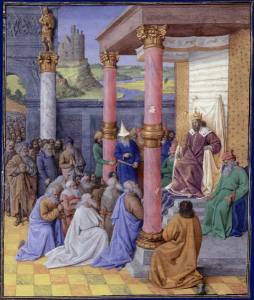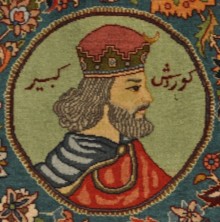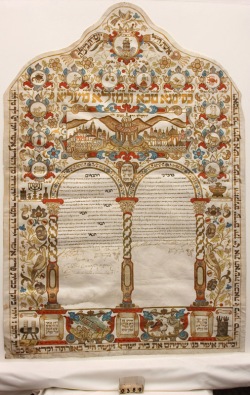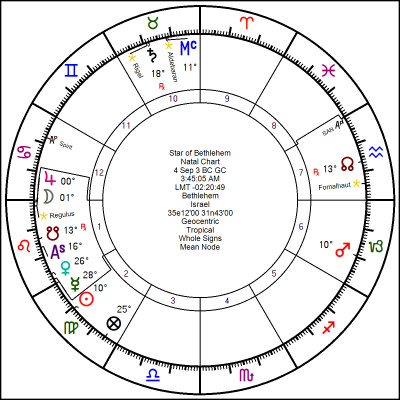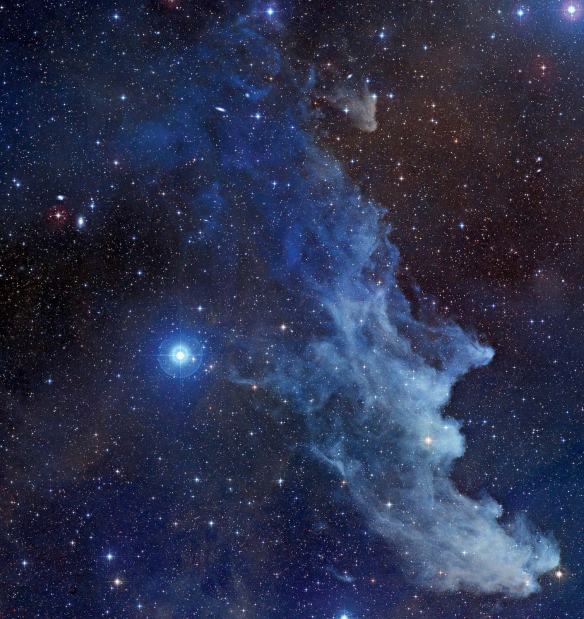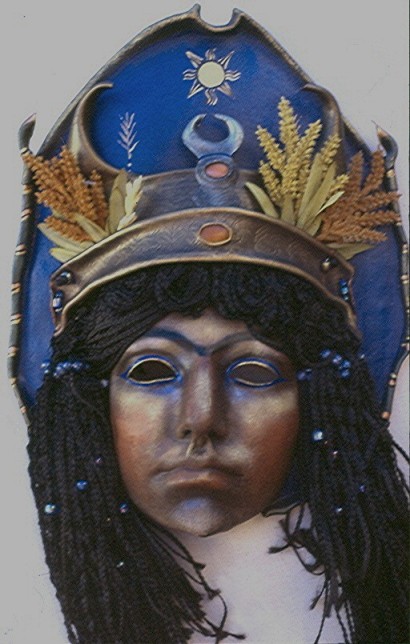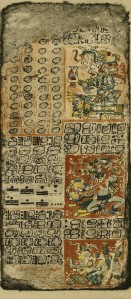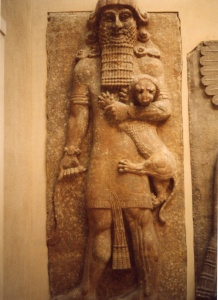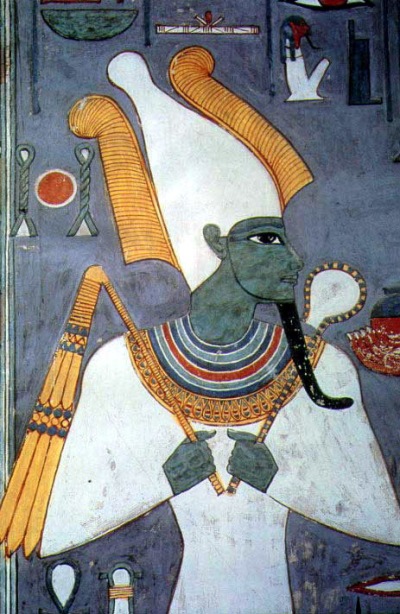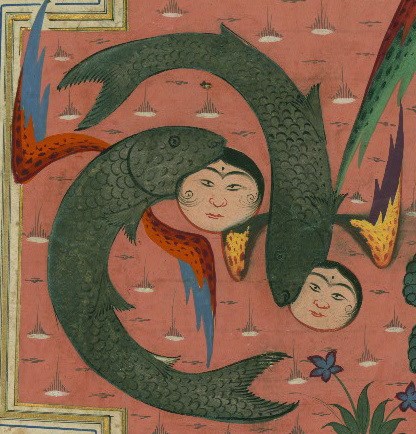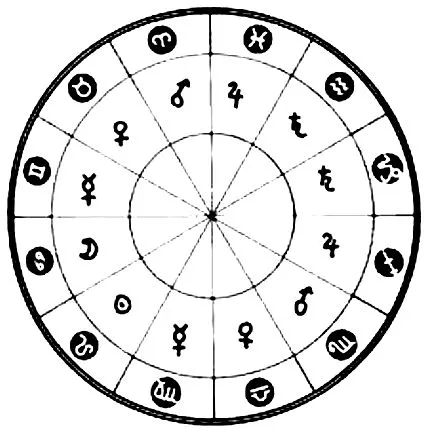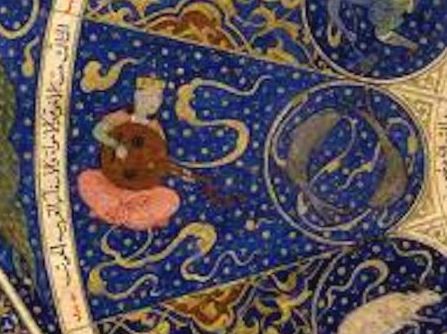Find more material on the philosophy of Marsilio Ficino and associates on Joe Kiernan’s Channel
Category Archives: Venus
The Magi & The Star-Child
Let me begin by stating clearly that I make no pretence to have finally solved the riddle of the Magi. I do hope that this short piece will contribute in a positive way to the ongoing study of the subject. In writing articles of this type, one needs to study the most recent scholarship as well as the ancient sources still extant. We may never know how much knowledge has been lost over the centuries, but we do know it was a great deal. These losses included the library of Alexandria and wholesale destruction of libraries during the Muslim invasions from North Africa, Persia and as far as India.
This continues from the two previous articles on the identity and nature of the Magi in particular relation to the Christmas story which combines Jewish and Persian elements. But first, it must be remembered that it is a story and it cannot be assumed that the narrator himself thought it to be an account of a temporal event. A story is not necessarily untrue, but it is a different kind of truth than the recalling of an historical event.
Further, our modern notion of historical accuracy is a fairly recent development. All cultures have maintained a mythological dimension to their own histories and it is often the case that the mythological tells us more about the society and its part in the greater cosmology than a historical “fact” might do. The latter is also subject to selective memory and various interpretations, while the former is more or less deliberately symbolic in nature. A popular and condescending euphemism for this second type of writing is “pious fiction.” The modern world needs to recover the meaning of an epiphany if it expects to understand ancient texts as they were intended to be read.
I intend to take a circuitous approach to explain what I have come to understand about the story of the Magi, involving solid astrology, interpreting mythological traditions as well as cultural realities.
Mark Kidger, an astronomer, writes that if the object was as bright as is reported in the Protovangelium of James, it would have to be at least as bright as the Moon and would have been recorded all over the world. He asks: was the star really brilliant? Did these early accounts use artistic license? Which of the accounts, if any, was the “correct” one? Where we even supposed to take the story of the Star literally? The Bible and the Apocryphal Gospels were never intended to be exact histories of the life of Jesus …. they are works written by the faithful for the faithful, and for those the writers hoped to convert.” (The Star of Bethlehem: An Astronomer’s View p. 19).
The interconnectedness and relative familiarity with different cultures in the Middle East, Rome, Greece, Egypt, and Persia are well documented but often trivialized. One cultural advantage of empires is the massive and facilitated flow of ideas, including familiarity with other languages. The Jews had been subjugated by the Romans, Babylonians, and Persians. Since the conquest of Alexander, they lived in a Hellenized world and it made for a heady mix. What emerged was a high degree of syncretism. One example was the existence of the Pharisees, a corruption of Parsi. The Jews appear to have adopted the idea of an afterlife in the Pharisee tradition, where the Sadducee school remained disinterested. The idea of an afterlife was shared by other cultures, but it would appear to be Zoroastrianism and the Persian influence that was primary
Certainly, the existence of the Magi was well known and their reputation was all but universally considered one of benevolence. Just as importantly, the Zoroastrian tradition had influenced the Greeks long before Plato, as well as Judaism. Jesus is considered by many scholars to be an Essene or at least influenced by them. The theme of the sons of darkness and sons of light has no other obvious equivalence than Zoroastrianism. We don’t find this theme in Greek or Jewish thought. Neither do we find it in Egyptian religion.
When we consider the details of the Christmas story, the role of the Magi is fascinating. First of all, the Jews were expecting a triumphant Messiah – a King of Kings from the House of David. The story of the virgin birth of a holy child, destined to redeem humanity and openly challenge the Judaism of the times is not what they had in mind. The humble birthplace of Jesus has become a symbol of humility to Christians, but it couldn’t have helped the Jews to accept him as the Messiah. Beyond Talmudic teachings, the case against Jesus being the Messiah derives from several key Scriptures: Isaiah 11:1-9, Isaiah 2:3-4, and Micah 4:2-3 among them.
The Christmas story might be seen as an attempted rebuttal to the disdain in the Jewish community. However, there is far more to it than that. The story may have been an attempt to illustrate a number of things, even if that meant excessive embellishment and resorting to “pious fiction.”
There have been countless attempts to identify the “star of wonder” ranging from a possible conjunction of Jupiter and Venus to a comet and a supernova. None of the theories so far has triumphed and we are left with the distinct possibility that the star being followed was of a spiritual nature – what we might call an inner light. No astronomer has been able to identify what it was – or if anything extraordinary was seen at all. My personal view is that the theories set forth haven’t taken the whole astrological picture into account.
The first “modern” attempt to discover what identifiable astronomical events could explain the star over Bethlehem really was conducted by Johannes Kepler identifiable astronomical phenomenon lies behind the biblical story of the so-called Star of Bethlehem was effectively begun by the astronomer Kepler (1571–1630),. Kepler was the mathematician to Rudolph II, Holy Roman Emperor
1576–1612. “In the years 1604–5 a supernova appeared in the constellation Ophiuchus and excited considerable discussion in Europe. Kepler kept a detailed record of his observations of the star. In the preceding year, 17 December 1603, at Prague he had also witnessed a conjunction of the planets Jupiter and Saturn with Mars moving into the vicinity soon after, which interested him in his capacity as court astrologer. The supernova appeared in the neighbourhood of these three planets. In

Jupiter-Saturn Conjunction Chart. Image credit: Star of the Magi
medieval times the conjunction of Jupiter and Saturn, known as the “great conjunction” (recurring only once every 19·86 [incorrect] years on average), was regarded as of great astrological significance. Kepler calculated that a similar conjunction with Mars moving into the vicinity soon after had occurred in the year 7 B.C. = Julian year 39. On that occasion, the conjunction had been a triple conjunction, a very much rarer event than the normal single conjunction.” (Sachs, A., & Walker, C. (1984). Kepler’s View of the Star of Bethlehem and The Babylonian Almanac for 7/6 B.C). At the end of the day, it turned out that Kepler had miscalculated and ever since then, one attempt after another to identify the star has failed.
William Eamon provides a summary of the process: “Kepler believed that the new star was a portent of deep significance. It was, he concluded, “an exceedingly wonderful work of God.” In 1606, he published a pamphlet, De Stella Nova in Pede Serpentarii (On the New Star in the Foot of Serpens), describing his discovery. Kepler was convinced that the new star was the same as the one that the Three Kings followed on their way to Bethlehem. With somewhat tortured logic, he reasoned that the new star was the equivalent of one that appeared in the same constellation around the time of the birth of Christ. He identified the supernova with a star that appeared in a conjunction of Jupiter and Saturn during the years 7-5 B.C. Since the supernova of 1604 appeared in the same conjunction, he reasoned, it had to be the same as the Star of Bethlehem that showed the Magi the way to Jesus.” (Kepler and the Star of Bethlehem)
It is crucial to remember that the Christmas story was written down long after the alleged events. Although not all scholars are in agreement, the majority believe that Mark was the first Gospel to be written, sometime around the year 70. This consensus has it that the Gospel of Matthew and the Gospel of Luke was written down sometime in the 9th or final decade of the 1st century. Obviously, this casts the authorship into doubt. It has been countered that the original four evangelists had completed gospels that were then transcribed by others at a much later date. However, the record doesn’t support this at all. Even the choice of which gospels would be included had a political and tendentious element in their selection.
Nevertheless, those who insist that everything written in the Bible is to be taken as literal truth will need to deny any metaphorical meaning at all. For the rest of us, we are free to consider the possibility that some passages or stories in the Bible are powerfully metaphorical and that metaphor and elaboration can add to the power of the truth being told, even if it had no actual historical existence. It does not seem out of place here to mention that the modern understanding of history conforms to linear time. The very idea of linear time is an extreme abstraction with no modern scientific basis. It is part of the materialist creed.
Zoroastrianism, like Christianity, is a Universal religion. As mentioned, the Jews also had every reason to venerate the Magi, emissaries from the East: The following is what is known as the Proclamation of Cyrus from Ezra 1:1-8 (ESV):
1 In the first year of Cyrus king of Persia, that the word of the Lord by the mouth of Jeremiah might be fulfilled, the Lord stirred up the spirit of Cyrus king of Persia, so that he made a proclamation throughout all his kingdom and also put it in writing:
2 “Thus says Cyrus king of Persia: The Lord, the God of heaven, has given me all the kingdoms of the earth, and he has charged me to build him a house at Jerusalem, which is in Judah. 3 Whoever is among you of all his people, may his God be with him, and let him go up to Jerusalem, which is in Judah, and rebuild the house of the Lord, the God of Israel—he is the God who is in Jerusalem. 4 And let each survivor, in whatever place he sojourns, be assisted by the men of his place with silver and gold, with goods and with beasts, besides freewill offerings for the house of God that is in Jerusalem.”
5 Then rose up the heads of the fathers’ houses of Judah and Benjamin, and the priests and the Levites, everyone whose spirit God had stirred to go up to rebuild the house of the Lord that is in Jerusalem. 6 And all who were about them aided them with vessels of silver, with gold, with goods, with beasts, and with costly wares, besides all that was freely offered. 7 Cyrus the king also brought out the vessels of the house of the Lord that Nebuchadnezzar had carried away from Jerusalem and placed in the house of his gods. 8 Cyrus king of Persia brought these out in the charge of Mithredath the treasurer, who counted them out to Sheshbazzar the prince of Judah.
Among the classical Jewish sources, besides the Bible, Josephus (1st century AD) mentions that Cyrus freed the Jews from captivity and helped rebuild the temple. He also wrote to the rulers and governors that they should contribute to the rebuilding of the temple and assisted them in rebuilding the temple. A letter from Cyrus to the Jews is described by Josephus.:
KING CYRUS TO SISINNES AND SATHRABUZANES SENDETH GREETING.
“I have given leave to as many of the Jews that dwell in my country as please to return to their own country, and to rebuild their city, and to build the temple of God at Jerusalem on the same place where it was before. I have also sent my treasurer Mithridates, and Zorobabel, the governor of the Jews, that they may lay the foundations of the temple, and may build it sixty cubits high, and of the same latitude, making three edifices of polished stones, and one of the wood of the country, and the same order extends to the altar whereon they offer sacrifices to God. I require also that the expenses for these things may be given out of my revenues. Moreover, I have also sent the vessels which king Nebuchadnezzar pillaged out of the temple, and have given them to Mithridates the treasurer, and to Zorobabel the governor of the Jews, that they may have them carried to Jerusalem, and may restore them to the temple of God. Now their number is as follows: Fifty chargers of gold, and five hundred of silver; forty Thericlean cups of gold, and five hundred of silver; fifty basons of gold, and five hundred of silver; thirty vessels for pouring [the drink-offerings], and three hundred of silver; thirty vials of gold, and two thousand four hundred of silver; with a thousand other large vessels. [Note] I permit them to have the same honour which they were used to have from their forefathers, as also for their small cattle, and for wine and oil, two hundred and five thousand and five hundred drachma; and for wheat flour, twenty thousand and five hundred artabae; and I give order that these expenses shall be given them out of the tributes due from Samaria. The priests shall also offer these sacrifices according to the laws of Moses in Jerusalem; and when they offer them, they shall pray to God for the preservation of the king and of his family, that the kingdom of Persia may continue. But my will is, that those who disobey these injunctions, and make them void, shall be hung upon a cross, and their substance brought into the king’s treasury.”
And such was the import of this epistle. Now the number of those that came out of captivity to Jerusalem were forty-two thousand four hundred and sixty-two.”
The somewhat terse account in Matthew is expanded upon, with both similarities and differences in the apocryphal Protoevengelium of James. This work is overwhelmingly concerned with Mary, Joseph, establishing the legitimacy of the Christ child and answering all the kinds of questions that might be asked about a virgin birth and the birth of the Christ child. James also gives us this:
“21. And, behold, Joseph was ready to go into Judæa. And there was a great commotion in Bethlehem of Judæa, for Magi came, saying: Where is he that is born king of the Jews? For we have seen his star in the east, and have come to worship him. And when Herod heard, he was much disturbed and sent officers to the Magi. And he sent for the priests, and examined them, saying: How is it written about the Christ? Where is He to be born? And they said: In Bethlehem of Judæa, for so it is written. And he sent them away. And he examined the Magi, saying to them: What sign have you seen in reference to the king that has been born? And the Magi said: We have seen a star of great size shining among these stars, and obscuring their light so that the stars did not appear; and we thus knew that a king has been born to Israel, and we have come to worship him. And Herod said: Go and seek him; and if you find him, let me know, in order that I also may go and worship him. And the Magi went out. And, behold, the star which they had seen in the East went before them until they came to the cave, and it stood over the top of the cave. And the Magi saw the infant with His mother Mary, and they brought forth from their bag gold, and frankincense, and myrrh. And having been warned by the angel not to go into Judæa, they went into their own country by another road. .”
If we come to these passages expecting to learn of a physical celestial event, that is what we will understand. However, this is not the only possible interpretation of ” a star of great size shining among these stars, and obscuring their light, so that the stars did not appear; and we thus knew that a king has been born to Israel, and we have come to worship him.” Could this not be written in the same spirit as “The light shineth in the darkness” in the Gospel of John? As I mentioned, the greatest irony of a belief in literalism is that it ignores that the very act of writing or story-telling is
metaphorical. They are part of how we process what we see. Even a technical manual will, more often than not, contain language that is not entirely literal. Turning to Judeo-Christian scripture we recognize that a direct command to “love your neighbour: can be taken at face value, even if understanding precisely what that means is subject to interpretation. The story of Jonah and the whale is a good case in point. We know that what happens in the story is impossible to explain using scientific principles. People cannot live inside whales, but if we out our material doubts aside, the story is rich in metaphorical meaning. Not believing that humans can live in whales is not cause for accusations of blasphemy except by the most extreme and demented American Evangelical Fundamentalist.
Many stories in the Bible are replete with metaphorical thought and in many cases re-telling of stories from other cultures, such as Egypt and Babylon. They are not primarily historical documents, although that are many who treat them as if they were.The first task of scripture is to impart spiritual truths and present material that illustrates the way of righteousness and the consequences of ignoring the wise. In that sense, Hindu scripture is of the same kind. There may very well be historical references, but history itself is not the most important factor.
There are many elements here that are immediately germane to the art of astrology. The more mystical the content, the more literalism falls away. What is above, is below. We are born of stars and the light we experience is microcosmic as well as macrocosmic. We speak of illuminated minds and an inner light. We also speak of the benighted consciousness and the “outer darkness.” In the Gospels, the “exterior darkness” or “outer darkness” is a place referred to three times in the Gospel of Matthew (8:12, 22:13, and 25:30) into which a person may be “cast out”, and where there is “weeping and gnashing of teeth”.
“The Sages and the Star-Child: An Introduction to the Revelation of the Magi, An Ancient Christian Apocryphon” is the title of a PhD dissertation by Brent Christopher Landau of The Faculty of Harvard Divinity School.
Landau “analyzes a poorly-known ancient Christian apocryphal writing, termed the Revelation of the Magi. This document purports to be the personal testimony of the biblical Magi on the coming of Christ, and is the longest and most complex narrative devoted to the Magi surviving from antiquity.” The thesis is compelling and at the very least provides a fairly detailed first-hand account of the experience from the Magi point of view.
The entire dissertation is available online, so I see no useful purpose in rehearsing it here, but there are several things that need to be said. The purpose and general focus of this series of articles on the Magi are on magic, metaphor, and astrology. Here we have an astronomical event that probably didn’t occur at all, read by Magi who were astrologers. The realization that the star was Christ himself, in perhaps a similar sense as we see in his transfiguration. All three Synoptic Gospels tell the story of the Transfiguration (Matthew 17:1-8; Mark 9:2-9; Luke9:28-36). With a remarkable agreement, all three place the event shortly after Peter’s confession of faith that Jesus is the Messiah and Jesus’ first prediction of his passion and death.
Perhaps the greatest anathema to astrology according to Christian theologians is the mistaken view that astrologers believe the stars dictate what will happen to individuals and societies. In their view, this somehow circumvents the will of a supreme being, when in fact the astrologer reads the signs to gain knowledge of divine will. Sorcerers and fortune tellers are considered to be cut from the same cloth as astrologers. However, in Judaism and Zoroastrianism, the stars are clearly understood to be useful and several books in the Jewish Bible, such as The Book of Daniel are saturated with astrological meaning. Yet in the Tanakh, we find The metaphor of the clock and time is germane here. The clock doesn’t create time, it just tells you what time it is.
It’s increasingly apparent that the importance of astrology in Judaism increased during the Babylonian captivity and the strong and friendly contacts with the Persians, who maintained a fairly practical form of the art.
It should be noted that there very few Jews would deny the presence of astrology in the Tanakh, but there would be reservations s well. – However, “two biblical passages dealing with the diviner (menaḥesh) and soothsayer (me’onen; Lev. 19:26; Deut. 18:10) were understood by the rabbis as bearing relation to astrology (Sanh. 65b–66a; cf. Maim. Yad, Avodah Zarah 11:8, 9). The prophets were aware of the practices of “star-gazers” (ḥoverei ha-shamayim) among the Babylonians and other peoples but they scoffed at them (Isa. 47:13; Jer. 10:2). In the book of Daniel the Babylonian astrologers arecalled kasdim (Chaldeans), and in Aramaic kasda’ei (2:2, 4, 5, 10; 4:14; 5:7, 11). The Sibylline Oracles (219–231) praise the Jewish people for refraining from astrology, which is a delusion. The Book of Jubilees (12:16–18) depicts the patriarch Abraham as overcoming the beliefs of the astrologers. The first Book of Enoch (8:3) includes astrology among the sins spread among mortals by the primeval giants (nefilim). Josephus, however, writes that astrology was common among the Jews in his days and that Jewish misinterpretation of celestial signs was partially responsible for the outbreak of the revolt against the Romans and its continuation for four years (Jos., Wars, 6:288ff.)”Source: Encyclopaedia Judaica. © 2008 .
1300 years later, Moses Maimonides was vehemently opposed to the practise of astrology, but his view had virtually no influence on subsequent Jewish writers. Astrology had become an integral element of Judaism. After all, the Yiddish mazel tov derives from Hebrew words meaning a constellation of good stars and destiny. Considering the extraordinary influence and reputation of Maimonides, this stands as a strong endorsement of astrology by the Jewish community.
“With the exception of Joseph Judah ibn Aknin and his enthusiastic admirer R. *Jedaiah ha-Penini (Bedersi), none of the Jewish philosophers of the succeeding generations opposed or deprecated astrology. Even the rationalistic *Levi b. Gershom maintained that the activities and events of a man’s life were predestined by the positions and movements of celestial bodies. The astrologers fail, he asserted, first of all because of insufficient knowledge about the movements of the stars and the effects of their changed positions on sublunar beings, and secondly, because of the intervention of intellect and free will, “for the intellect and the will are empowered to carry us beyond the limitations imposed by the celestial bodies” (Milḥamot Adonai 2:2). Shem-Tov ibn *Falaquera also considered astrology a true science and made use of it. Many of the great rabbis, commentators, preachers, and ethical teachers dealt with astrology and were favourably disposed toward it; *Abraham b. David of Posquières, in his Hassagot, a commentary on Maimonides’ Mishneh Torah; *Naḥmanides (Commentary on Gen. 1:16; Lev. 23:24, and passim) and his pupil Solomon b. Abraham *Adret (Responsa, no. 652); *Baḥya b. Asher (Commentary on Ex. 11:4; and passim); Isaac *Aboab (Menorat ha-Ma’or, 143; passim); Simeon b. Ẓemaḥ *Duran (Magen Avot, 72bff., and Tashbeẓ, no. 513); Isaac *Abrabanel , who cited many proofs “from the science of astronomy in regard to the celestial conjunctions” for his opinion that the redemption of Israel would begin in 1503 and come to completion in 1531 (Ma’yenei ha-Yeshu’ah, 12:2); Isaac *Arama (Akedat Yiẓḥak, 34, 56), though he disapproved of eschatological reckonings based on astrology; Moses b. Ḥayyim *Alshekh ; *Judah Loew b. Bezalel (Maharal) of Prague, who is reputed to have practiced astrology in the company of his friend Tycho Brahe; David *Gans ; Leone of *Modena ; Joseph Solomon *Delmedigo of Candia, Jonathan *Eybeschuetz ; and *Elijah , Gaon of Vilna (Commentary on Sefer Yeẓirah). A definitely negative attitude toward astrology was assumed by Azariah dei *Rossi” (Me’or Einayim, 42, 43). Source: Enyclopaedia Judaica. © 2008c
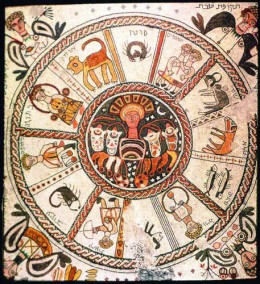
Detail of the ancient kibbutz Beth Alpha mosaic, Israel: a zodiac wheel with all 12 symbols and names of the zodiac, surrounded by four female figures at the corners, identifying the seasons of the year; at the centre, Helios, the sun god driving a quadriga, with moon and stars. (Picture: Art Resource, NY; biblicalarchaeology.org/via @Inés Peschiera Kežman Pfeifer)
Most importantly, traditional astrology views the stars as microcosm and the macrocosm. In most cases, we study the macrocosmic heavens to shed light on the microcosm. In the case of the Star Child, we have the Magi reading the advent of Christ by an inner illumination. This appears to be the message when we have looked at all the sources and considered the identity of the players in this cosmic drama. We talk about “outer space” but there is a corresponding “inner space.”
Of course, the proclamation that the Kingdon of Heaven is within you is used only by Matthew. Mark and Luke used “kingdom of God” Compare Matthew 11:11-12 with Luke 7:28; Matthew 13:11with Mark 4:11 and Luke 8:10; Matthew 13:24 with Mark 4:26; Matthew 13:31 with Mark 4:30 and Luke 13:18; Matthew 13:33 with Luke 13:20; Matthew 18:3 with Mark 10:14 and Luke 18:16; and Matthew 22:2 with Luke 13:29. The two phrases clearly mean the same thing.
If we revisit words of the Magi in Matthew: “Now after Jesus was born in Bethlehem of Judea in the days of Herod the king, behold, wise men from the East came to Jerusalem, saying, Where is He who has been born King of the Jews? For we have seen His star in the East [or at its rising and have come to worship Him ” we are left with a tantalizing and evocative image, but we still don’t have any idea what this rising star was. It was common to refer to planets as stars, but there isn’t anything close to bright enough to match the description.
If we take this account at face value and ignore the impossible exaggerations which have, ironically, obscured all the main points, we would have a chart very similar to this.
This chart shows the rising of Jupiter the king planet, in the royal sign of Leo and with the Kings’ star, Regulus. This certainly fits with the description of the Star in the East. It is ascending ahead of the Sun with enough clearance from the Sun to allow visibility.
Regulus, in Leo (The Lion), means “little king,” named by Copernicus. It is the heart of the Lion and associated with generosity and ambition. If well aspected it will raise the person to high positions in life and denotes successful activity. Its nature is Mars and Jupiter. Bayer name Alpha Leo. Apparent magnitude +1.3 This star rising with Jupiter would have been considered a strong indicator of the birth of a king when combined with the other elements present.
Some have suggested that “born of a Virgin” means the Sun in Virgo. I see no compelling reason to take this view, but it may be worthy of further research. We can say that the Sun in Virgo is suggestively positioned.
The triple conjunction of Venus and Mercury and the Ascendant with Jupiter would make for a convincing candidate for the birth of a great king in Babylonian as well as Persian astrology. The Moon is in her domicile in Cancer and Mars in his Exaltation is safely in the 6th house, like a tiger in a cage. This is where Mars has his Joy.
Saturn retrograde and conjunct the Midheaven is more sinister. The Jews are under the governance of Saturn and this new king is not welcome by the highest authorities. There is a tight conjunction of Saturn with the fixed star Rigel, the brightest star in Orion, The Hunter (Apparent magnitude +0.3) The star is of the nature of Jupiter and Saturn and associated with fame, wealth, and lasting honours. Rigel is a fortunate star and a very powerful one. This would serve as a protective element.
This is the most likely way that the Magi determined the location of the birth. Saturn conjunct the MC is in the place of authority. It is only natural that they would visit Herod.
I make no claims to this being the exact date, but the time would be close enough to provide us with an accurate enough and relatively short window for this configuration to occur, making this a strong candidate for something approaching what must have occurred.
It seems ironic that many of the attempts to embellish and exaggerate the message of the Magi have obscured what might otherwise have been obvious.
The Magi are what scripture and tradition say they are – highly skilled astrologers, almost certainly from Persia. There has been a number of attempts over the years to make them appear to be like a Unicef greeting card depicting them as all Jewish kings from Yemen.
I don’t believe that The Star-Child account is meant to be taken entirely literally, but it is a rather lovely narrative of the Star leading to the Child. For approximately two billion Christians, Christ is their Guiding Star
Commentary on Averrores – BBC
Abū l-Walīd Muḥammad Ibn ʾAḥmad Ibn Rushd (Latinized as Averroes), lived from 14 April 1126 – 10 December 1198. He was a Medieval Andalusian polymath who wrote profusely on logic, Aristotelian and Islamic philosophy, theology, the Maliki school of Islamic jurisprudence, psychology, political and Andalusian classical music theory, geography and mathematics, Averroes is of great importance in Islamic philosophy for multiple reasons. He argued for the reconciliation of reason with revealed religion, pointing out passages from the Qu’ran to support his position. He was a powerful proponent of Astrology for the same reasons. He was accused of shirk or polytheism, for referring to the planets, and most particularly Venus, as if they were divine. He was exiled but eventually embraced back into court in Morroco.
Inanna & the Eternal Feminine
The above artwork is from an unknown source. If anyone knows the identity of the artist, please drop me a line. It’s a great interpretation of a goddess who often looks more like a harpy in some of her traditional representations.
The attributes are all there, from the grain sheaves to the eight-pointed star, the horns of the Bull of Heaven, the lapis lazuli in her hair as well as the lunar symbols. Her gaze has something of hypnotic quality and there is something disquieting about the whole thing, with her dark, hollow eyes, she has a decidedly nocturnal countenance. She is fierce as well as strangely beautiful. There is nothing ornamental about her in the Venusian sense. She is the primary Sumerian goddess and Queen of the Night and Queen of Heaven.
If you’ve followed this blog over the last two years or so, you have seen me return to the theme of the early Middle Eastern, Sumerian, Babylonian and Pre-Islamic Arabian archetypes of the powerful Feminine deities which are more fully developed origins of Aphrodite and Venus. The record is very clear that what we consider the Classical deities associated with the planets and luminaries are the result of the devolution of original archetypes and, to some extent, made far more superficial than most astrologers realize..
This kind of research is problematic. We find that what is Classically known as Aphrodite and the planet Venus is represented in Sumer by a goddess that might be associated as well with planets other than Venus, including Mars and the Moon. There is also Sin, a male Moon-god, so the matter may become complicated in short order. Nevertheless, the Sumerian model is worthy of serious consideration in the quest for the essence of Venus.
The Classical Venus is not without nuance of course, but when we compare the understanding to Inanna, I think it safe to safe the archetype has been drained of much of its potency and the raw power of the Primal Feminine. Inanna, also known by the later Babylonian and Mesopotamian names of Ishtar and Astarte, is not primarily a goddess of love, but one who embodied war, wisdom, agriculture, sex, fertility, prostitution and lust, as well as a representative of the vegetative cycle itself and the traveller to the underworld. In Classical mythology, Mercury is the psychopomp, the guide to the Underworld.
Inanna is an active heroine. The recognition of the archetype immediately associated with Inanna goes as far back as far as 8,000 years.
Modern astrologers rarely, if ever, take into account whether Venus is the Morning or the Evening Star. We have a ‘one size fits all’ goddess who is prone to misunderstanding.
The Venus cycle is of crucial importance and to ignore that is to risk running amok in interpretations. The two primary phases of Evening and Morning star have very different qualities, but Inanna encompasses both in any case, making her a representative of the Feminine in all her guises.
Some Feminist astrologers have suggested that the goddess only took on the qualities of a warrior much later when the Middle East had become more violent. There are two problems with this.
There never was a time of anything much more than fleeting peace. The dream of an ancient society permanently at peace under a matriarchy is just that. In any case, in the earliest written work, Inanna is already a fully developed warrior of Heaven, the Earth and the Underworld.
She also demonstrates that there is no hell like a woman scorned, probably more than any woman before or since. In Tablet VI, Inanna desires King Gilgamesh, but Gilgamesh turns her down, citing the horrific fates of all her previous lovers. She goes into a blind rage and demands of her Father that she be allowed to release the Bull of Heaven t gore Gilgamesh to death. Her father refuses at first, pointing out that Gilgamesh might have a very good point. Her threats become ever more horrible and daddy eventually surrenders to her rage. In this, she can seem all too human, but she is in a trinity with the Sun and the Moon and she is of inestimable power.
It gets worse. The Bull is killed and Enkidu throws it back into the heavens to form a constellation, thus adding insult to injury.
It seems normal that her traits would display a degree of androgyny. She is courageous, quick-tempered, fertile and wrestles to create justice and balance in the most sublime, as well as the most savage.way. Her association with the scorpion and owls make her seem more like Lilith than Venus. In fact, Lilith is her adversary in the Sumerian creation myth. Lilith poisons the tree that Inanna had nurtured. More properly, we can say that Lilith is parasitic, as we shall see.
The poem begins: “when what was needful had first come forth,” when bread first started to be baked in ovens of shrines, and when the first separation occurred, that of sky and earth ” (Frayne 2001:130; Wolkstein & Kramer 1983: 4). A violent tempest uproots a huluppu tree, which Inanna rescues and plants in her own “sacred grove” at Uruk (Frayne 2001: 131).
Unfortunately, three beings settled in the tree: in its roots “a snake which fears no spell”; in its trunk a lilitu, a female spirit; and in its branches the Anzu bird.
Unable to rid herself of these intruders and parasites, Inanna is reduced to tears and calls upon her brother Utu, the sun god for help, but he refused, The hero Gilgamesh, Uruk’s warrior king, agreed to assist. Gilgamesh “smote” the snake, the others fled. Gilgamesh felled the tree, taking the branches for himself, The trunk was given to Inanna in a gesture that is difficult to fathom.
Presumably, it means that Inanna got the roots of the tree, In another version of the story, Gilgamesh uproots the tree, thus severing the connection of earth, heaven, and the underworld.
There are few passages in ancient literature that could out-do the erotic courtship of Dumuzi and Inanna and I’m certain there was never a better-crafted story of the descent to the Underworld on Tablet VI.. The imagery is stark., terse, vivid and terrifying. She is visiting her sister, Ereshkigal and makes elaborate preparation for the descent.
The following is from Table VI Descent Of Inanna Wolkstein – Kramer edition.
“Naked and bowed low, Inanna entered the throne room.
Ereshkigal rose from her throne.
Inanna started toward the throne.
The Annuna, the judges of the underworld, surrounded her.
They passed judgment against her.
Then Ereshkigal fastened on Inanna the eye of death.
She spoke against her the word of wrath.
She uttered against her the cry of guilt.
She struck her.
Inanna was turned into a corpse,
A piece of rotting meat,
And was hung from a hook on the wall….
Then, after three days and three nights, Inanna had not returned,
Ninshubur set up a lament for her by the ruins.
She beat the drum for her in the assembly places.”
She has become dead meat hanging on a wall. Her return to life by way of the intervention of Dumuzi is if course nothing short of a resurrection. With Venus in mind, we may well consider this as a metaphor for her stages of apparent and concealed visibility as part of her cycle The problem is first and foremost the specificity of three days from a culture well aware of the Venus cycle. In any case, the subject matter is quite unlike what we usually refer to as Venusian.
Quite simply, Inanna, Ishtar and Isis don’t have all that much in common with Venus at first blush. The Moon, Mars, Jupiter, Mercury and Saturn could all be described by her nature. In fact, the only luminary/planet that doesn’t fit is the Sun. By comparison, the Greco-Roman Venus seems rather thin and limited.
In the ancient Near East, Ishtar was an important and widely worshipped mother goddess for many Semitic* peoples. The Sumerians* called her Inanna, and other groups of the Near East referred to her as Astarte.
Inanna is a highly complex deity, combining the characteristics, both good and evil, of many different gods and goddesses. As a benevolent mother figure, she was considered the mother of gods and humans, as well as the creator of all earthly blessings. In this role, she grieved over human sorrows and served as a protector of marriage and motherhood. People also worshipped Ishtar as the goddess of sexual love and fertility. The evil side of Ishtar’s nature emerged primarily in connection with war and storms, much of it born of jealousy and rage. As a warrior goddess, she could make even the gods tremble in fear. As a storm goddess, she could bring rain and thunder, these events are now connected primarily to the Moon and Jupiter.

The eight-pointed star of Ishtar appears at top left, the crescent moon of the Moon God Sin is at top center, and the symbol of the Sun God
In the story of Inanna, she is the daughter of the male Moon god Sin and sister of the sun-god Shamash. Others mention the sky god Anu, the Moon-god Nanna, the water god Ea, or the god Enlil, lord of the earth and the air, as her father. Most myths link her to the planet, Venus.
There are a few things one can do with this comparison. The simplest and probably least disruptive would be to take a closer look at what we mean by our mythical association of Venus with the planet that bears her name and also what we mean by the Feminine. Venus is a goddess with tremendous limitations. But perhaps the greatest of these is that is not a mother goddess. Whereas earlier depictions of the feminine, whether it be Ancient Near Eastern or Celtic represented her in three phases: the Maiden, the Mother and the Crone, Venus pretty much remains on the first stage, allowing the Moon to take the other attributes.
Of course, astrology uses the Greek and Roman Pantheon as metaphors for the planets. However. it’s all too easy to forget that and our understanding of the planet itself is likely to suffer. The price paid during the advancement of civilization can be significant and I think it’s quite fair to say that the Greek and Roman Pantheon has little of the depth and earthy honesty of earlier cultures.
I’m certainly not suggesting that we give up on Venus, but we do well to remember the vast heights and depths that are found in abundance in earlier sources when it comes to a more complete representation of the Feminine. This article does little more than introduce some issues regarding Astrology and the Feminine. I hope it sparks some interest.
Vernal Equinox & Nowruz 2015

Bas-relief in Persepolis, . A Zoroastrian symbol of Nowruz – on the vernal equinox the powers of the eternally fighting bull (personifying the Earth) and lion (personifying the Sun) are equal. (Licence Wikipedia)
Nowruz is among the most ancient and significant astrologically based holy days celebration in the world. It began with Mithraism and Zoroastrianism and is still celebrated with zeal in several countries from Azerbaijan, Russia, Syria, Turkey , India and of course Iran. A repeating theme is the allegory of the balance of light and darkness illustrated by the bas-relief shown above. This is echoed in the celebration of Ostera or Easter which falls on the first Sunday after the first full Moon in Spring. It represents earthly fertility in the waxing day force as well as spiritual resurrection. What is above, is below.
The Aries Equinox chart is always of great significance, but here we have the confluence of a Solar Eclipse just hours before the Ingress, @ 29°27′ Pisces. This is a rare event and worthy of our close attention. This is a rare event and worthy of our close attention. We start with a reading of the chart of the year. The undisputed Lady of the Year is Venus in Taurus: Occidental, direct, free of the beams, in sect and of course in her domicile She protects from external enemies. .Mars is also in his domicile,in sect and in hiss house of Joy.and Aries is the Exaltation of the Sun.  The sixth house is the house of the common people in Mundane charts and here there are in a strong position, even with the unfortunate Moon in Aries. That leaves us with an unremarkable Mercury in Pisces, in his Fall but nicely placed by house and both Social Planets retrograde. Saturn in Sagittarius, Peregrine isn’t well placed at the best of times, but in the Second House income is seriously restricted and curtailed
The sixth house is the house of the common people in Mundane charts and here there are in a strong position, even with the unfortunate Moon in Aries. That leaves us with an unremarkable Mercury in Pisces, in his Fall but nicely placed by house and both Social Planets retrograde. Saturn in Sagittarius, Peregrine isn’t well placed at the best of times, but in the Second House income is seriously restricted and curtailed
This applies to the nation more specifically than to the individual. Jupiter in Leo, the domicile of the Sun occupies the Tenth House and is indicative of rulers, Although he enjoys some elemental sympathy from the Common People, we can say Jupiter is inflated and worst of all retrograde, symbolically moving away from the “throne.” The sympathy is amplified by the Sun in the Sixth House.This denotes the fall of a leader, Considering the pomp and circumstance of Leo, this may very well refer to a prominent member of the aristocracy or Royal Family.  The video below shows the progress and visibility of the eclipse. Eclipses affect most those nations and cities that fall under the sign of the eclipse as well as where it is visible. This would include Egypt, Normandy, North Africa, Portugal and Scandinavia. My primary focus is on the United Kingdom and those places in the same time zone and visibility of the eclipse although much of what I have to say would apply in a lesser extent to Europe, Western Russia and the Piscean nation of Egypt, the latter of course in a very volatile state. The time if the eclipse at GMT falls ominously in the 10th House. It`s almost as if the eclipse sets the stage for the fall of the *monarch* Jupiterean Pisces turns off the lights while Saturn holds the Seventh House. It isn’t hard to read this fairly literally. We could say that the strong Mars in the Eleventh House lends support to the Tenth, but with the S, Node and really no mitigating elements, it might very well do more harm than good.
The video below shows the progress and visibility of the eclipse. Eclipses affect most those nations and cities that fall under the sign of the eclipse as well as where it is visible. This would include Egypt, Normandy, North Africa, Portugal and Scandinavia. My primary focus is on the United Kingdom and those places in the same time zone and visibility of the eclipse although much of what I have to say would apply in a lesser extent to Europe, Western Russia and the Piscean nation of Egypt, the latter of course in a very volatile state. The time if the eclipse at GMT falls ominously in the 10th House. It`s almost as if the eclipse sets the stage for the fall of the *monarch* Jupiterean Pisces turns off the lights while Saturn holds the Seventh House. It isn’t hard to read this fairly literally. We could say that the strong Mars in the Eleventh House lends support to the Tenth, but with the S, Node and really no mitigating elements, it might very well do more harm than good.
The significance of an Eclipse is in the larger picture of the nation or nations rather than on the lives of individuals specifically, but of course whatever affects the nation will affect the people, sometimes in major ways and more often in ways that are not immediately detected. If you celebrate only one or two things a year, the Vernal Equinox is highly significant – the forces of darkness and light are balanced with the forces of light, with the Sun waxing in the Sign of his exaltation.
The Bull of Heaven II
I make no pretense of being an expert in Egyptology, but there are some fundamental elements of that culture which allow us to see Taurus in a different way, in part by the relationship of the Bull of Heaven to Osiris
The region of the heavens occupied by the constellation Taurus is home to several powerful fixed stars from Algol (above left) the Pleiades, the Hyades and Aldebaran, the red eye of the bull – Watcher of the East and one of the Royal Stars of Persia. Babylonian astrologers would also be very interested in the stars associated with the horns – unsurprisingly they tend to be of the nature of Mars. However, as an entity we can see the essential nature of Taurus is Lunar and Venusian.
The cultural interpretation of a constellation surely says something about the culture itself. The ravaging bull in eternal conflict with Orion the Hunter is a very good case in point. It takes more than simple imagination to see Orion as a brutal hunter wielding a spiked club at Taurus and to see Taurus as a determined wild bull bent on Orion’s destruction. Orion is just as often portrayed as an archer, aiming at the Bull’s eye! This is a rather violent view. Of course nothing is wrong just because it’s violent, but in this case we have what I believe is a far more convincing and satisfying interpretation.
Looking once again at the image at the top of part I, the white calf rising with the Sun is Apis. He is the Ka of Osiris:
“In ancient Egyptian religion, with the ba and the akh, a principal aspect of the soul of a human being or of a god. The exact significance of the ka remains a matter of controversy, chiefly for lack of an Egyptian definition; the usual translation, “double,” is incorrect. Written by a hieroglyph of uplifted arms, it seemed originally to have designated the protecting divine spirit of a person. The ka survived the death of the body and could reside in a picture or statue of a person” Britannica

The Egyptian hieroglyph for the Venus cycle from Morning to Evening Star in the shape of a perfect pentagram as viewed from Earth.
When we change the name and perception from Orion to Osiris, the idea of the god Osiris, the consort of Isis, charging to deal a deathly blow to his own life force is as silly as it’s poignant. In Egypt as in so many ancient cultures, the motif of bull’s horns with solar disks are all but universal. We find them shown even in the depiction of pre-Islamic Arabian deities.
 In the sky map to the left,Sirius, the brightest star in the sky from our viewpoint, follows Osiris closely and is associated with Isis. The rising of Sirius signaled the inundation of Egyptian farm land by the Nile. The association doesn’t end there, though. The Egyptians considered the Milk Way to be the “real Nile” just as many Hindus consider the Milk Way as the “true Ganges.” as even so called inanimate objects have soul in the Egyptian view, the relationship of Earth to the Heavens was divine and inexorable. We could say that they mirrored each other. Other articles related to Sirius
In the sky map to the left,Sirius, the brightest star in the sky from our viewpoint, follows Osiris closely and is associated with Isis. The rising of Sirius signaled the inundation of Egyptian farm land by the Nile. The association doesn’t end there, though. The Egyptians considered the Milk Way to be the “real Nile” just as many Hindus consider the Milk Way as the “true Ganges.” as even so called inanimate objects have soul in the Egyptian view, the relationship of Earth to the Heavens was divine and inexorable. We could say that they mirrored each other. Other articles related to Sirius
Egyptian religion wasn’t particular dogmatic and did in fact differ from one time and region to another to some extent. However, the primacy of Isis as the Queen of Heaven and of life itself, her brother Osiris the Lord or King of the dead, thier son Horus, god the Sun, Sky and Kingship, was widely understood.
Gwen Parker: tells us that when an Apis bull died “the body was embalmed and entombed with the great ceremony that would be afforded royalty. A Memphis temple housing large alabaster slabs was the place in which the bulls were embalmed.
After preparation of the body and internal organs, the crouching bull was intricately bandaged, artificial eyes were inserted, its horns and face were either gilded or covered with a gold leaf mask, and it was covered with a shroud. The Apis mummy was carried to the Serapeum (a catacomb preceded by an avenue of sphinxes), amid the formalities due a deity, for burial in a massive stone sarcophagus weighing over 60 tons. A papyrus from the 26th Dynasty explains the technique used to embalm an Apis bull.”
Wearing the crown. with the Royal insignia of the flail and crook on his hands, Osiris looks more like a shepherd king than a hunter. His best known epithets are “eternally good” or “eternally incorruptible” and his relationship with the Bull of Heaven is both essential and benign, and offers profound insight to the nature of the Bull.
Isis and Hathor share various feminine qualities, with Hathor being more of a Luna deity and Isis being the Queen and Guardian of the path of the planets.
It’s easy to mistake one for the other, particular if Isis is not shown with wings. At the end of the day, we still have the Moon exalted in Taurus and Venus Isis ruling both Libra and Taurus. The Ankh carried by Isis is a slightly modified glyph for Venus, with the circle of Spirit and Cross of Matter. The cross differs from the modern glyph only slightly. The cross is further up towards the centre of the whole symbol, suggesting a greater level of relationship with Spirit perhaps.
We now know that the Bull of Heaven held a very important position in both Sumerian and Egyptian culture, possessing mystical qualities. Taurus, the Moon and Venus are all feminine and I cannot help but wonder how this came to be seen as something to be clubbed or shot. I might suggest this has something to do with the denial of the Divine Feminine. Even Paleolithic paintings of Orion, crafted by hunter gathers do not associate him with a hunter. He is a Shaman. See the Stars of Orion.
The extraordinary astronomical knowledge and skill of these ancients is staggering. Mapping the Venus Pentagram alone shows uncommon skill and all these things should give us pause when interpreting Venus or the Bull of Heaven.
Venus Exalted in Pisces
One of the most tortured and misunderstood concepts in astrology is that of Exaltation. There are two main reasons why this is the case. First of all, modern astrologers are either unaware that a mystical system exists that permeates and underlies all astrology or fail to see its relevance. Worse perhaps, is that there is awareness of this system, but the modern practitioner takes for granted that it can be changed to suit ‘modern sensibilities’ or ignored altogether.
If you can’t see why the system is the way it is, then what’s the harm in throwing a few extra planets or asteroids in for good measure? Who cares if there are enough asteroids to provide over a hundred of them for every degree of the zodiac? While we’re at it, why not add some new aspects because, you know, our subtle energies vibrate to a New Age to which the ancients had no awareness. They only used the seven planets and the five aspects because they didn’t know any better. Somebody ought to channel Pythagoras and let him know.
So when the question arises as to why a planet is exalted in a sign, those sufficiently divorced from the tradition, might attempt to understand it using, let’s say, psychological criteria that become increasingly exotic and usually highly subjective. In the case of Venus in Pisces, we are told that only Pisces can give unconditional and Universal love whereas Venus in other signs is presumably incapable. Universal love or agape isn’t what Venus is about. She is associated with Eros, music, seduction, sweets and so on. Recently I read that Venus is exalted in Pisces because Venus was born from the sea, more accurately sea foam, which sounds good until you realize that Pisces is not the ocean. That belongs to Cancer.
A brief search on the internet will provide several other stock explanations that make little sense when examined in the light of reason or by simple reference to the system that brought about exaltations in the first place.
The most direct technical answer to the question. ‘why is Venus exalted in Pisces.’ is to note that it’s opposite the Fall of Venus in Virgo. Exaltations are always in the opposite sign of their Fall Let’s begin with the Domicile of the Signs: below is the list of domiciles for each planet and luminary. With the exception of the Sun and Moon, all planets have two domiciles. One is Masculine or Diurnal and the other Feminine or Nocturnal.
The system is a perfect symmetry, but may not appear to be at first glance.. If we take the Sun and Moon as the centre, then the rulerships follow the Chaldean order of planets. So for example, Mercury takes Gemini and Virgo as domicile – that is to say the sign before and the sign after the Luminaries. Next will come Venus in Taurus and Libra Finally Saturn is left with Capricorn and Aquarius. See the diagram below.
In summary:
The Moon has only one Domicile, Cancer – Nocturnal Feminine
Mercury has his Domicile in Gemini and Virgo – Diurnal Masculine and Nocturnal Feminine
Venus has her Domicile in Taurus and Libra Nocturnal Feminine and Diurnal Masculine
The Sun has only one Domicile, Leo – Diurnal Masculine
Mars finds his domicile in Aries and Scorpio – Diurnal Masculine and Nocturnal Feminine.
Jupiter has his Domicile in Sagittarius and Pisces. Diurnal Masculine and Nocturnal Feminine
Saturn has his Domicile in Capricorn and Aquarius – Nocturnal and Feminine and Diurnal Masculine.
These Saturnine signs oppose the Luminaries: Capricorn is the detriment of the Moon and Aquarius the Detriment of the Sun. Saturn is the greater malefic. The domiciles of Mars, Aries and Scorpio, oppose both domiciles of Venus, Libra and Taurus respectively. Jupiter the greater benefic has Sagittarius and Pisces for his domicile. Diurnal Jupiter trines the Sun and is Exalted in the domicile of the Moon. From this alone, it is easy to see why Saturn is the greater malefic and Jupiter the greater benefic.
Mercury appears to upset the balance by having his Domicile and Exaltation in Virgo, while he takes both detriment and Fall in Pisces. Venus then takes her fall in Virgo and exaltation in Pisces. This is because Jupiter opposes both domiciles of Mercury and vice versa.
Returning to Pisces, we find nocturnal Jupiter opposing Virgo, which is trine nocturnal Venus – thus Venus is exalted in Pisces. The system is simple once one knows how to read it. Remember this is only one way of measuring planetary strength. Domicile is considered to be of greater dignity than Exaltation.
My sole intention in writing this article is to explain the nature of exaltations and because Venus is exalted in Pisces at the time of writing. With this in mind, it’s neither the time or place to debate possible archetypal meanings. However, there is no doubt that Venus is very happy in the sign of the Fishes, but the happiness is more sensual than mystical in the ordinary sense of that word. After all, we have the greater benefic with the lesser benefic Venus in the House of Jupiter will not auger restriction. In the words of Mae West ““Too much of a good thing can be wonderful.”
The final analysis will look to the phases of Venus. She is known as Phosphorus as the evening and Lucifer as the Morning Star, but that is for another article.
Winter Solstice 2014
First allow me to wish everyone a joyous solstice, with blessings of all kinds, as we celebrate the return of the light in the Northern hemisphere. The recognition of the importance of the Sun appearing to stand still before he begins to move towards the North is celebrated virtually universally in many variants from the beginnings of recorded history and surely long before. This is the time to welcome and celebrate the return of the Sun, See my previous article for the symbolism, lore and practise of the Winter Solstice
The Solar symbol of the dot within a circle is one of th3e most ancient symbols. The Sun is the primary source of life. The Chart for the Year is cast for 0° Aries, the Exaltation of the Sun.
The Winter Solstice charts provides us with relatively short predictions which are concerned specifically with season on Winter. Solstice Charts are generally used to tell us of the current climate, both literally and figuratively and employed with a particular interest in the season itself. That is not to say they cannot provide us with more. For people living close to the Ring of Fire, earthquake and tsunami warnings are crucial. These predictions also include weather predictions of a general nature because we are talking about a three month period.
Below is the chart for the Winter Solstice 2014, including the seven hermetic lots. It is drawn for the West Coast on 21 December 2014, 15.03 PST. Victoria, B.C. This gives us a chart for Day of the Sun and Hour of the Moon.
The angles are in Mutable Signs and Mercury, the most Protean of all planets is in Capricorn and the Almuten Figuris. He is of course also Lord of the Ascendant Moreover, the Lady of the Geniture is Venus, also in Saturnine Capricorn. The essence of the chart is Cold and Dry, or Melancholy, by Humour.
Sun, Moon and Mercury are all in the 22nd Lunar Mansion, known as the Head of the Dragon. The significance of this is speed, escape or personal power. Particularly because this is a Mundane chart, this planet and luminaries is stifled in the Eighth House. The Moon is Balsamic and Void of Course and the traditional decanate ruler is Saturn. The Sun is in the Decanate of Jupiter. The New Moon in Capricorn occurs at 5.25 pm
The Mercurial Hyleg is the Pars Fortuna in the First House, conjunct the Fixed Star Aldebaran, the Eye of God, in the fourth Lunar Mansion and often associated with blindness. The fact is the position of Al Debaran (the follower of the Pleiades) is crucial in interpretation. It is far better to have this star on the Ascendant, than in the Seventh for example. One of the Royal Stars on Persia, he is Watcher of the East. He can bring greatness if integrity and nobilit6y of character is preserved.
According to Vivien Robson, ” It gives honour, intelligence, eloquence, steadfastness, integrity, popularity, courage, ferocity, a tendency to sedition, a responsible position, public honours and gain of power and wealth through others, but its benefits seldom prove lasting and there is also danger of violence and sickness.” [Robson Fixed Stars p.120.]
Aldebaran and the Pleiades are a prominent sight during Winter in the Northern Hemisphere
Mercury is Combust. Venus is Under the Solar Beams. The glimmer of hope lies in the fact that both the Lot of the Sun, the Moon and Venus are found in the First House with the Day and Hour of the chart underscored.
In the Seventh House of open enemies, we have the Moon at 28.35° conjunct Acumen. This is interpreted as enduring attacks that weaken. The position of the Lot of Saturn only emphasizes the difficulties. Jupiter is extremely weak because he is deposited by the Sun in the Eighth House, retrograde and Peregrine – like a stranger in a strange land. As Lord of the Seventh he isn’t in a position to ameliorate.
We look then to Mars in the Ninth House and on the MC. in the 23rd Lunar Mansion known as the “fortunate aviator.” There is a suggestion here of attack from the air. Saturn is Lord of Mars, Sun, Venus and Mercury. Saturn is found in the Sixth House. and in Mutual Reception with Mars.
We have the potential for an attack – religiously motivated because of Ninth House placement – but on a limited scale, if not intercepted entirely But there is definitely a need for heightened vigilance, Again, we largely create what happens to us within prescribed limits and forewarned is forearmed
What initially appeared to be a fairly straightforward chart proves to be complex and suggestive of the following:
The weather will be changeable, from dry and cold to high winds and heavy rainfall. There is no indication of a major seismic eruptions, always of concern for those of us living on the West Coast, over the next three months. There is no indication of a Tsunami on the West Coast either.
The lot of the people collectively is somber and in need of leadership with vision and integrity. I would anticipate on-going protests to be particularly energized.
We are not passive observers in either our individual or collective lives. If the season is Cold & Dry we may elect to embrace its opposite, which in this case is Sanguine, or warm and wet. This can be facilitated by the strong Mercurial signature in the chart, even with the afflictions. There is a reason that warm soup tastes especially good in the cold weather. Mild and pungent spices as well as squash, carrots and other root vegetables may also help, unless there is some other reason you shouldn’t eat these foods. If you are already of a Sanguine Humour, increasing its preponderance will server no useful purpose
Greet the return of the light with lanterns, candles, yule logs and solar incenses such as Sandalwood, Frankincense and Dragon’s Blood. ,
Venus & the Temple of the Sun
This is really not much more than a brief note and inquiry into the nature of the Sun and Venus when they are very closely associated. – in this case in a very beautiful and enigmatic work of art
It’s been my contention for most of my life as an astrologer that Aphrodite is a charming but inadequate personification of the celestial Venus. It is necessary, I think, to broaden one’s view by examining various associations , not just Hellenistic ones, to get a glimpse of the many layers of meaning and variety of expressions to fully understand the significance of the planetary archetype.
There are few better opportunities for this study outside of the Western tradition than that afforded by the temple of Konark , a 13th century Sun Temple,  at Konark, in Odisha, India. It was apparently built by king Narasimhadeva I of the Eastern Ganga Dynasty around 1250. This temple to the Sun god Surya is built in the form of a Solar chariot, drawn by seven spirited horses.
at Konark, in Odisha, India. It was apparently built by king Narasimhadeva I of the Eastern Ganga Dynasty around 1250. This temple to the Sun god Surya is built in the form of a Solar chariot, drawn by seven spirited horses.
The motif of the Sun in a chariot drawn by horses is ubiquitous in the ancient world, although the details do differ. Here we have time represented by the months of the year, seven days of the week and the number of hours in a day. The chariot wheels themselves are decidedly Solar, but there is also poetry, music and dancers described among the erotic figures and hence we find ourselves very much in the fuller spectrum of all things Venusian. In fact, this is very much the realm of the Fifth House where Venus finds her joy
Venus is known as Shukra in Indian mythology and is male. Shukra means semen, so the associations of fertility and creativity only strengthen the fifth house associations.
Shukra is however also represented by a female deity, most commonly, Lakshima, but there are obvious and close associations with Sarsawati, the patron of music, poetry and learning. The temple appears to embrace the Venusian within the larger Solar context.
This may seem confusing, but is much less so if you consider the Fifth House. First and foremost the house is the realm of all that is creative, including offspring and pleasure in music, poetry and sex. This is the house of Good Fortune in Hellenistic astrology and the parallels between the European and Indian conceptions becomes apparent, as do their differences .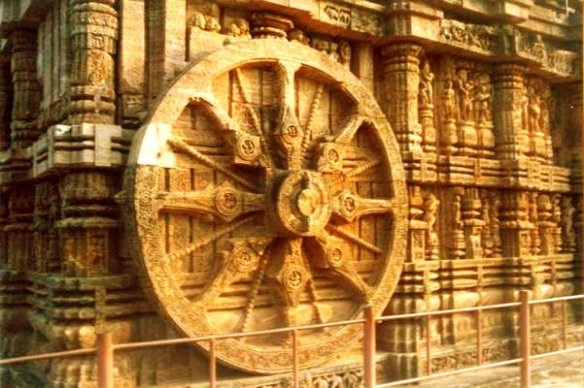
Consider firstly the relationship between the Sun and Venus in the symbolism of this temple’s construction. Its more than proximity of deities. It expresses a deeply intimate relationship to the Sun and Venus. Like all great art, it leaves us with many questions, but the study is time well spent
The Taurean Venus
Planets and Signs are Archetypes. Astrology is an art that considers the microcosm in relation to the macrocosm. That isn’t a modern idea. It’s an ancient one. So when we talk of the astrological Venus we refer to a rich matrix of attributes, each of which will manifest according to her Sign, her placement and her relationship to other planets and luminaries.
The glyph for Venus consists of the circle of Spirit, having precedence over the cross of matter. In medicine and in all the biological sciences it is still the symbol for the feminine. Venus is the Ruler of both Taurus and Libra. In this article, I will be focusing on what I will call the Taurean Venus. This is her Earthly domicile. She is very much at home here, so it affords an opportunity for discussion of this particular expression of the Venus archetype
Venus is the Ruler of both Taurus and Libra. In this article, I will be focusing on what I will call the Taurean Venus. This is her Earthly domicile. She is very much at home here, so it affords an opportunity for discussion of this particular expression of the Venus archetype
Taurus is a fixed earth sign and here Venus is the Earth Mother or womb from whose energy the earth receives the beauty of the natural world, as well as the comforts and pleasures it may afford. In Taurus, Venus is in her dignity and is best described as the voluptuary, a lover of physical, earthly beauty. This is the embodiment of Eros.
As the Sun waxes in Taurus, the Earth is green and full of new life. Venus delights in beauty, including the arts of poetry, dance, music and visual art. She’s the creative force that bringing new life through erotic love as well as procreation. She rules the sense of touch. In Classical Astrology, she is naturally said to take her joy in the fifth house.
Venus was identified in tradition as the daughter of the Moon. The Moon and Venus are both reflective, feminine archetypes in the chart.
Venus is more than the figure of Aphrodite can describe. In Classical mythology she was a powerful, but potentially treacherous deity.
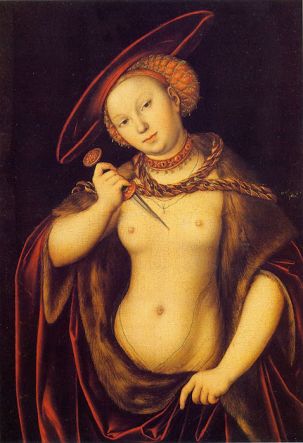
Lucretia Borgias by Lucas Cranach- A Darker Side of Eros gone awry. Cranach did a few paintings on the same theme, But here there is some ambiguity. Lucretia committed suicide but had poisoned countless people. She has been considered as an erotic serial killer .
The metal associated with Venus is copper. We know that copper is widely used in the cosmetic industry! In alchemy, Venus is externally beautiful and highly receptive, but with a corrosive core.
The Venus cycle corresponds to the gestation period and underscores her role as bringer of life.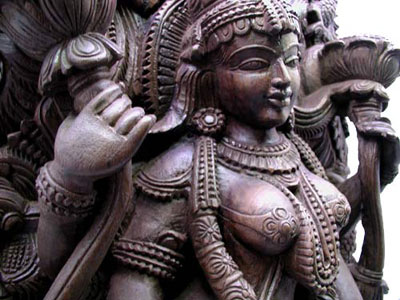
- Lakshmi – The Hindu Goddess of Wealth & Beauty
In Babylonian tradition she was a “star” in a trinity with the Moon and Sun. She was at one time personified as the Great Goddess who gave birth to the Sun, and at other times known as Lucifer, the light-bearing attendant to the Sun.
As River and Gillespie have written, the deities associated with Venus in the Ancient Near East were “active initiators, for they brought in the day, awakening solar vitality. As the gentle and loving Evening Star, Venus was Zib, Hesperus and Shalem,said to speak the Word of Peace nightly to the Sun, giving the Hebrew and Arabic word for peace, shalom and salaam.
As Evening Star, Venus returns to the lunar world of the imagination.” (The Knot of Time. p. 79). It is easy then to see her connection to the idealistic, spiritualized love of Pisces, the sign of her own exaltation.
The Venus element in the natal chart is a place of potential vibrancy and sensual delight. An unafflicted Venus in the fifth house can produce great artistic ability. Venus in the same house but afflicted and in a different sign, may signal no more than a profligate gambler.
In other cultures, such as India the equivalent of Ishtar, Aphrodite and Venus is revered as the Goddess Rati and as the Tantric Goddess Shakti. However. the most Venusian Hindu Goddess is Lakshima, particularly in relation to the Taurean Venus
In the painting above the god Krishna is enjoying the sensuality of earthly life. Many of the attributes of this painting seen quite Taurean to me.


